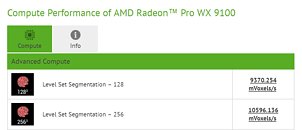Monday, July 3rd 2017

AMD Readies Radeon Pro WX 9100: Vega for Professionals
After releasing the Vega Frontier Edition, AMD's take on a "prosumer" GPU which straddles the line between a professional and gaming graphics card, with somewhat mixed results, AMD is apparently now working on the fully professional version of the Vega silicon. Identified as the Radeon Pro WX 9100 (which is in line with AMD's current professional nomenclature), this professional graphics card will look to fully accelerate professional workloads, with a driver specifically crafted for such.
Recently rearing its head on CompuBench, the GPU features a low 1200 MHz clock speed, which is around 402 MHz lower than the Frontier Edition, and supposedly lower still than the Gaming RX Vega variant of the GPU. The Vega-based WX 9100 joins the Polaris-based WX 7100, WX 5100 and WX 4100 professional graphics cards, thus apparently topping out AMD's professional line-up for the year.
Source:
Videocardz
Recently rearing its head on CompuBench, the GPU features a low 1200 MHz clock speed, which is around 402 MHz lower than the Frontier Edition, and supposedly lower still than the Gaming RX Vega variant of the GPU. The Vega-based WX 9100 joins the Polaris-based WX 7100, WX 5100 and WX 4100 professional graphics cards, thus apparently topping out AMD's professional line-up for the year.


33 Comments on AMD Readies Radeon Pro WX 9100: Vega for Professionals
7nm hasn't even reached the market yet and 14nm was postponed for more than two years, after that we had one year of 16nm GPUs that costed an arm and a leg. 14nm is here to stay for awhile, at least 3-4 generations of GPU.
About this VEGA positioning... this is AMD spotting a market where the rest of the world never knew it was there. And in a couple years time, the numbers will underline the fact that the world never cared.
Mines based on facts and announcements mate your going by history and hearsay.
And whats Nvidia using 16nm got todo with anything Amd didn't.
14nm was also announced for half a decade before it finally came to market, and when it did, the mobile space consumed stocks for a long long time.
Read back these comments in 2h 2018 and you'll nod in agreement. There is only one reason for all these announcements, and that is the need for investors and the creation of momentum to drive the adoption of the smaller node. Its strikingly similar to the 12901515181 announcements about the next best battery technology that never came, to secure budgets.
Did i say it better for you that way.
And no these announcement coincide with both plans and design schedules, a chip takes years to design for a specific node so even if the node isnt fully ready designs are made to fit its expected specs.
"Case in point, Samsung currently hopes to use EUV lithography for critical layers with their 7 nm nodes to avoid triple/quadruple patterning, but are being very careful in how they're wording their plans, saying that they are "reviewing possibilities" of EUV insertion at 7 nm. So it is not cast in stone that Samsung will not proceed with a DUV-only 7 nm if it has to. Meanwhile Intel also once considered to start using EUV for 7 nm. Finally, TSMC does not seem to be afraid of multi-patterning and intends to produce semiconductors using DUV-only 7 nm manufacturing tech in 2H 2018."
source: anandtech
Also, this;
www.semiwiki.com/forum/content/6631-euv-not-ready-7nm.html
We're actually talking about highly costly DUV lithography because EUV simply isn't good to go yet. In other words, everyone is at the stage where they know they can do 7nm, but the biggest hurdle will be economical of nature. A full DUV process will make the chip very expensive., much more so than the current node. The design phase is underway. But that is all she wrote... It seems highly likely that we'll see affordable consumer-7nm much later than 2018.
Worthy of note though and tied , Amd is likely to also beat Nvidia to an McM chip with Navi.
Lots of small gpus on an interposer with next generation memory not hbm.
This approach could make an expensive process workable for Gpus.